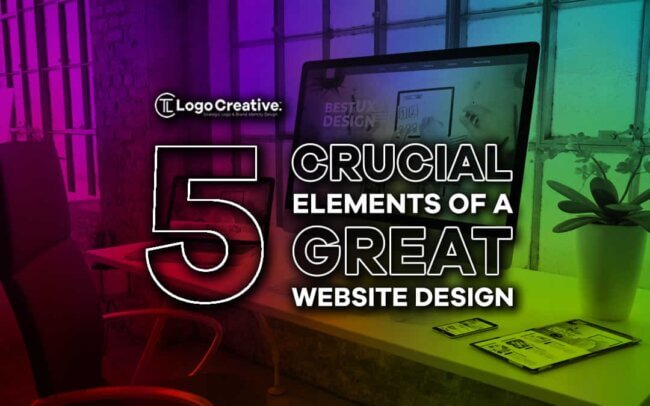If you have a business, you must have a website. It’s one of the best marketing tools you can use, allowing you to make your website more visible. In this article we share 5 Crucial Elements of a Great Website Design.
When building a website, keep in mind that first impressions count. So, you must ensure your site is well-designed from the get-go.
While you could create a website independently, designers like web design agency Melbourne are preferable. Remember that when developing a website, you must consider several design elements. Typically, only an expert would know how to incorporate all key web design elements to create a cohesive project.
That said, here are some of the crucial elements an excellent website design should have.
Table of Contents
1. Usability
You need to ensure that your site is usable. Poor usability affects the entire user experience. What good is a website if its users can’t use it properly? You must remember that visitors will go elsewhere if the site is challenging to navigate.
Therefore, your website must be intuitive to attract more users. Make the fonts large enough for users to read them on your site. Additionally, ensure all relevant information, including promotions and discount deals, is easily accessible to visitors on the homepage. A good rule of thumb is to keep things as simple as possible.
Furthermore, you must ensure that your website is compatible with smartphones and computers. People nowadays rely heavily on mobile devices, so you should also optimize your website for mobile use.
2. Navigation
Site navigation is crucial to the entire user experience. A user should not have to go through hoops to locate information on your website. Instead, it should be easy for users to find what they seek. If your website is navigable, it enhances the user experience, which may increase the chances of users returning to your site.
So, you must ensure that users get to where they want to with the fewest clicks possible. It’ll prevent frustration from the user having to click multiple times before getting to their destination. It’s also a good idea to use breadcrumbs. These make navigating your site much more straightforward. If users want to go back to a specific page, they can trace it back using breadcrumbs.
3. Visual Quality
The visual quality of a website is one of the first things users notice when they visit. More visible aspects, such as color palettes and infographics, immediately capture the user’s attention. However, there are also less apparent features, such as visual hierarchy. Nonetheless, you must ensure that your website’s visual elements are balanced.
It’s also essential to consider the quality of the images and graphics you use for your website. People can judge a site just by looking at its graphics quality. So, use high-quality photos and graphics on your website if you want people to perceive your brand as trustworthy.
Furthermore, you want to ensure that your website loads smoothly on all devices. Avoid using large files, as they will require more processing time and may adversely affect the user experience. Also, avoid having excessive elements on your website since they may slow down page load times.
-
Content Management System (CMS)
It’s crucial to have a reliable website. However, a website that is difficult to update or maintain serves no purpose. Unless you have exceptional coding skills, you’ll need someone to update the content on your website regularly. Alternatively, you could invest in a Content Management System (CMS).
Unfortunately, some website owners overlook the importance of a CMS and pay extra costs to hire designers or developers to make changes to their websites. Therefore, it’s recommended that you use a CMS for your website so you can update it whenever you need.
-
Search Engine Optimization (SEO)
It doesn’t matter how beautiful your website is. The site’s visual attractiveness is largely irrelevant if you aren’t receiving or generating traffic. As a result, it’s critical to ensure that your website is search engine optimized. SEO is essential since it helps increase your website’s visibility, resulting in more traffic.
A search engine looks for and displays relevant web pages whenever a user initiates a search. If your website is search engine optimized, it increases the odds that it will appear at the top of a search engine results page (SERP). Thus, the higher your website ranks, the better.
However, SEO is complicated. Only a skilled web developer or designer would know how to optimize your site for search. It’s usually best to optimize a website organically. But if you genuinely want to push your website, i engaging in paid SEO is wise. Nonetheless, it’s best to talk with your designer to determine which SEO methods you should use while developing your website.
Further Reading: More articles about Web Design.
Conclusion
Excellent website design is crucial because it helps to make better first impressions. But, more importantly, it allows you to rank higher in search engines. It may be tempting to do this yourself to save money. However, you may make costly design errors that may adversely affect user experience. So, it would be best to work with a professional website designer.
Join The Logo Community
We hope these 5 Crucial Elements of a Great Website Design have been helpful. If you would like more personal tips, advice, insights, and access to our community threads and other goodies, join me in our community.
You can comment directly on the posts and have a discussion with Andrew, the Founder of The Logo Creative.
*TIP – We recommend Skillshare to learn online. There are tons of classes for everything including graphic design, web design, marketing, branding and business-related courses. Get a free trial with our link and you won’t regret it Trust us!


